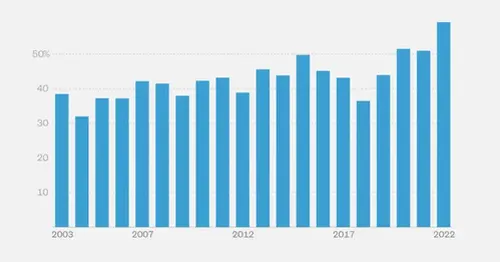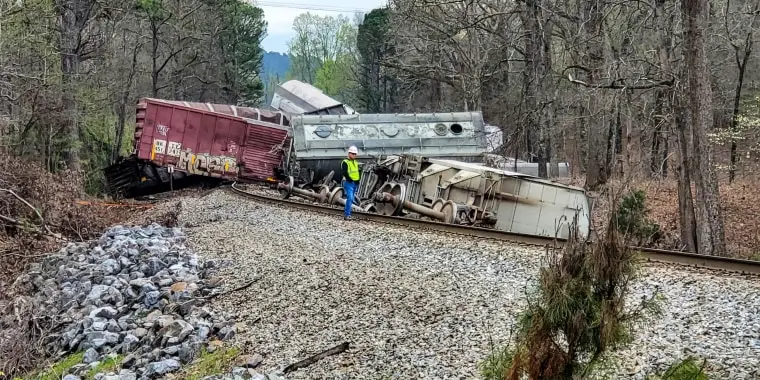
How Norfolk Southern's accident rate compares to other rail companies
Norfolk Southern, the company whose train derailed and released toxic chemicals in East Palestine, Ohio, last month, once had the lowest accident rate of all the major train companies in the U.S. But while other big rail lines have more than halved their accident rates in the past 20 years, Norfolk Southern’s has stayed largely the same.
A review of safety data by NBC News showed that from 2018 to 2022, Norfolk Southern averaged 0.88 accidents per million miles, which is slightly above the average of the country’s six other Class-I freight railroads over the same period.
By contrast, from 2003 to 2007, the other six train companies averaged 2.26 accidents per million miles, while Norfolk Southern boasted a low of 0.96.
Norfolk Southern’s rate has stayed relatively flat, even though it has made investments in safety systems and technologies at a level similar to its competitors.
As a category, train accidents include derailments, collisions and other similar incidents involving rail equipment.
Various stakeholders offer different explanations for Norfolk Southern’s stagnant accident rate. Critics point to a shrinking workforce and an increased workload, which they say has led to greater employee fatigue and human error as the company tries to buoy efficiency and profit. But Norfolk Southern says its accident rate has stayed about the same because its mileage traveled has gone down, shifting the ratio. As a raw total, the company says, its number of accidents has dropped 21% since 2019.
Connor Spielmaker, a Norfolk Southern spokesperson, noted that the rail company had fewer derailments in 2022 than in any other year of the past decade, and that its employee injury rate has improved by 35% since 2020.
However, leaders of the union of employees who work for Norfolk Southern say the workforce declines speak for themselves: Norfolk Southern had 18,100 employees at the end of 2021, according to documents it filed with the Securities and Exchange Commission, down from more than 30,000 in 2011.
Russell Quimby, who served as a National Transportation Safety Board accident investigator for more than 20 years, said that overall, train companies’ business has bounced back since pandemic lockdowns, but workforce levels have remained stagnant since prior reductions.
That has left train workers overwhelmed, he said.
“They’re lucky to get sufficient rest, so many are chronically fatigued all the time,” Quimby said. “That has a major effect on morale and safety.”
It’s possible that a contracting workforce played a role in the increasing share of Norfolk Southern accidents caused by human error, which rose from almost 40% of its accidents in 2003 to nearly 60% in 2022, according to data reviewed by NBC News.
That is the highest the figure has been in the past 20 years and about 10 percentage points higher than the average of the major train companies.
Norfolk Southern is not an outlier in laying off employees, though. As investors and stockholders have pushed rail companies to pursue precision scheduled railroading — an approach that attempts to maximize the number of rail cars moving within a scheduled timeline — many train companies have cut their workforces since at least 2016, according to an NBC News analysis of Surface Transportation Board data.
All seven major U.S. railroad companies have also increased the length of trains in recent years, according to a Government Accountability Office report published in December. One company, unnamed in the report, said the percentage of trains operating at nearly two miles in length increased from less than 3% in 2017 to more than 25% in 2021.
Meanwhile, the number of workers in charge of equipment maintenance declined by nearly 40% and train operators by almost 27% from 2011 to 2021, the report said.
Elizabeth Repko, the GAO’s director of physical infrastructure, said there is some anxiety that longer trains and smaller staffs could lead to breakdowns in safety. She added that railroad unions and inspectors have also raised safety concerns about crews not having the “appropriate training” to run these longer lines and suggested they require more work so could lead to greater fatigue.
“Having proper training and not experiencing fatigue are important safety issues that everyone agrees make a train’s operation more safe,” Repko said.
Jonathon Long, chairman of the American Rail System Federation union, said in a letter to Ohio Gov. Mike DeWine earlier this month that Norfolk Southern (which he referred to as “NS”) has been on a “quest for more record breaking profits at the sacrifice of safety.”
“Management representatives are given marching orders to exalt money over the integrity and safety of NS’s track structure and the safety of its Employees, because of NS’s cost cutting business model,” he wrote. Long did not respond to requests for comment.
The union also alleged that Norfolk Southern has relied increasingly on automation and technology, rather than workers, to maintain safety standards.

But Spielmaker said Norfolk Southern CEO Alan Shaw has committed to rebuilding the firm’s safety culture, vowed to work with regulators and continues to invest over $1 billion per year in new safety technology, equipment and infrastructure.
In December, he added, the company unveiled a new strategy that incorporates a “holistic approach to measuring success.”
“Part of that is how we handle our workforce, and this announcement followed many months of record hiring at Norfolk Southern to replenish our conductor workforce. Going forward, in times of economic downturn, instead of furloughing employees — we will train them,” he said.
Shaw told lawmakers while testifying on Capitol Hill last week that he is “deeply sorry” for the crash in East Palestine.
Following the derailment, Norfolk Southern announced a six-point plan to address safety concerns, though it does not change the size of the company’s workforce. Instead, the plan says it will increase investment in technology and join a federal program that enables railroads and employees to confidentially report safety concerns.
The National Transportation Safety Board said it has launched a special investigation of Norfolk Southern’s organization and safety culture. Since December 2021, the board said, it has launched five teams of investigators to probe significant accidents that involved Norfolk Southern.
Two of those incidents, including one that killed a Norfolk Southern employee, occurred this month.
Quimby said the investigation could take about a year.






